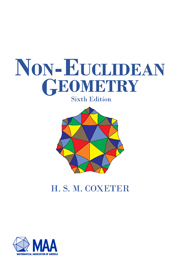Book contents
- Frontmatter
- PREFACE TO THE SIXTH EDITION
- Contents
- I THE HISTORICAL DEVELOPMENT OF NON-EUCLIDEAN GEOMETRY
- II REAL PROJECTIVE GEOMETRY: FOUNDATIONS
- III REAL PROJECTIVE GEOMETRY: POLARITIES, CONICS AND QUADRICS
- IV HOMOGENEOUS COORDINATES
- V ELLIPTIC GEOMETRY IN ONE DIMENSION
- VI ELLIPTIC GEOMETRY IN TWO DIMENSIONS
- VII ELLIPTIC GEOMETRY IN THREE DIMENSIONS
- VIII DESCRIPTIVE GEOMETRY
- IX EUCLIDEAN AND HYPERBOLIC GEOMETRY
- X HYPERBOLIC GEOMETRY IN TWO DIMENSIONS
- XI CIRCLES AND TRIANGLES
- XII THE USE OF A GENERAL TRIANGLE OF REFERENCE
- XIII AREA
- XIV EUCLIDEAN MODELS
- XV CONCLUDING REMARKS
- APPENDIX: ANGLES AND ARCS IN THE HYPERBOLIC PLANE
- BIBLIOGRAPHY
- INDEX
VII - ELLIPTIC GEOMETRY IN THREE DIMENSIONS
- Frontmatter
- PREFACE TO THE SIXTH EDITION
- Contents
- I THE HISTORICAL DEVELOPMENT OF NON-EUCLIDEAN GEOMETRY
- II REAL PROJECTIVE GEOMETRY: FOUNDATIONS
- III REAL PROJECTIVE GEOMETRY: POLARITIES, CONICS AND QUADRICS
- IV HOMOGENEOUS COORDINATES
- V ELLIPTIC GEOMETRY IN ONE DIMENSION
- VI ELLIPTIC GEOMETRY IN TWO DIMENSIONS
- VII ELLIPTIC GEOMETRY IN THREE DIMENSIONS
- VIII DESCRIPTIVE GEOMETRY
- IX EUCLIDEAN AND HYPERBOLIC GEOMETRY
- X HYPERBOLIC GEOMETRY IN TWO DIMENSIONS
- XI CIRCLES AND TRIANGLES
- XII THE USE OF A GENERAL TRIANGLE OF REFERENCE
- XIII AREA
- XIV EUCLIDEAN MODELS
- XV CONCLUDING REMARKS
- APPENDIX: ANGLES AND ARCS IN THE HYPERBOLIC PLANE
- BIBLIOGRAPHY
- INDEX
Summary
Congruent transformations. In the present section we describe those properties of perpendicularity, congruence, distance, angle, etc., which closely resemble their two-dimensional analogues. We mention also certain other properties which more closely resemble their one-dimensional analogues, because projective spaces of odd dimension are orientable. In contrast to 6.42, we find various kinds of congruent transformation: reflections, rotations, rotatory reflections, and double rotations. The last of these resembles the one-dimensional translation in leaving no point invariant. A special case of it, known as a Clifford translation, is intimately associated with the existence of pairs of skew lines which are parallel in the sense of 1.11. Most of this chapter is concerned with various devices for the elucidation of this fascinating idea, which is quite different from the hyperbolic parallelism described in §1.4.
As in two dimensions, so in three, we begin with real projective geometry, and introduce metrical concepts by singling out an arbitrarily chosen uniform (or elliptic) polarity, calling it the absolute polarity. Then every point A has an absolute polar plane a, every line AB has an absolute polar line (α, β), and every plane a has an absolute pole A. Every point of a is perpendicular to A, and every plane through A is perpendicular to a. The relation between two absolute polar lines is symmetrical: every point on the one is perpendicular to every point on the other, and every plane through the one is perpendicular to every plane through the other.
- Type
- Chapter
- Information
- Non-Euclidean Geometry , pp. 128 - 156Publisher: Mathematical Association of AmericaPrint publication year: 1998



